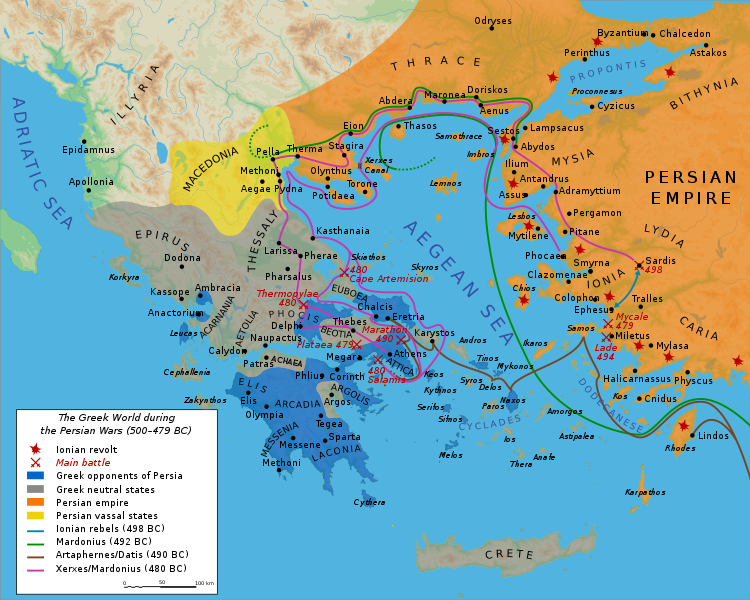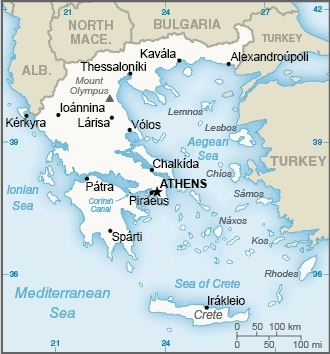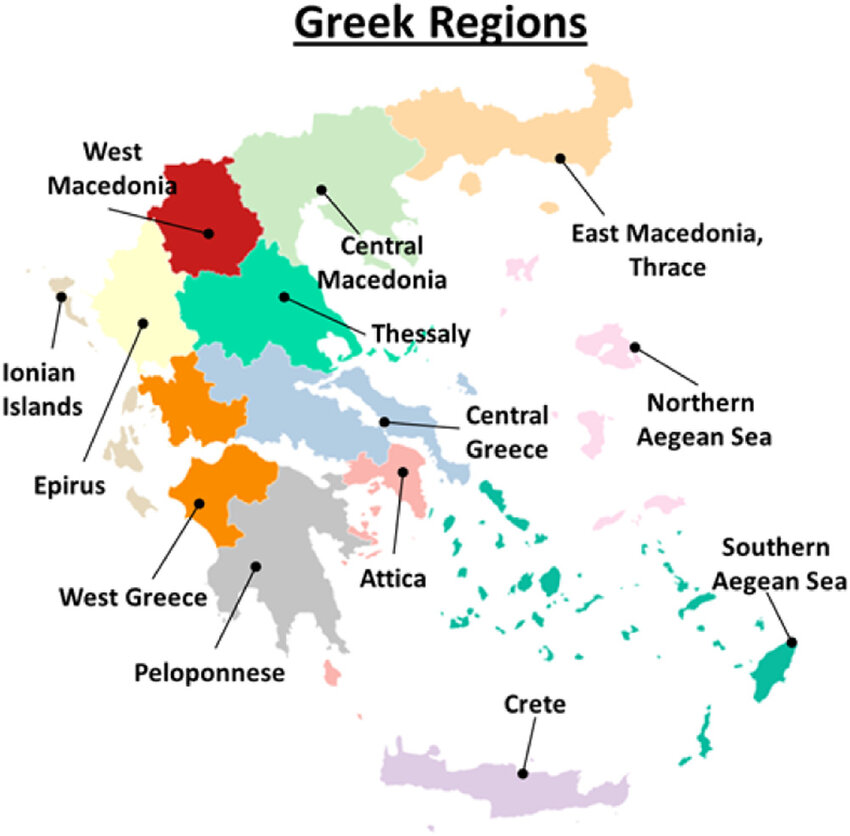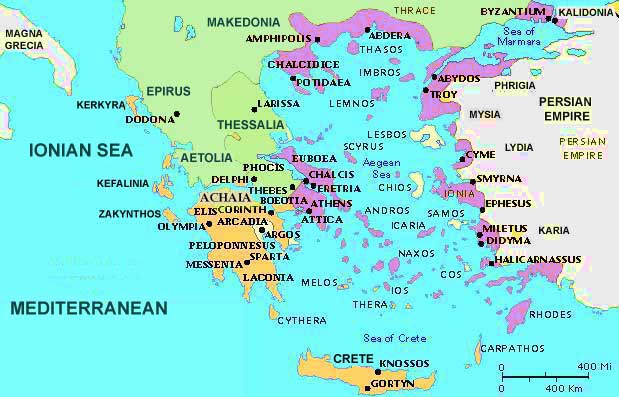Map Of Greece - Islands, Cities, Language & History Unveiled
Looking to plan your Greek adventure? This map of Greece covers everything: regions, islands, and hidden gems for the perfect getaway.
Author:Finn WildeReviewer:Michael RachalApr 17, 20258.3K Shares209.5K Views
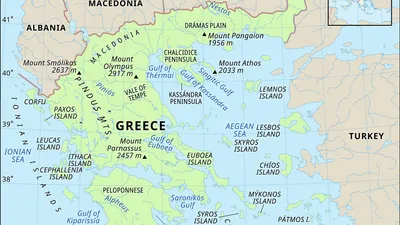
Greece stands as a timeless symbol of history and natural beauty, captivating travelers with its rich culture and breathtaking landscapes. From the ancient ruins of Athens to the pristine beachesof its countless islands, this Mediterranean gem offers endless wonders waiting to be uncovered.
Understanding the geography of Greece is key to experiencing its full potential. A map becomes more than a simple tool, it’s your gateway to navigating a country where myth meets reality. This article provides an essential guide to Greece’s layout, ensuring your journey is as seamless as it is unforgettable.
Quick Facts About Greece
- Capital: Athens
- Population: Approximately 10.3 million
- Language: Greek
- Currency: Euro (€)
- Dialing Code: +30
- Time Zone: Eastern European Time (EET)
- Area: 131,957 square kilometers
- Longest River: Aliakmon River
- Highest Mountain: Mount Olympus (2,918 meters)
- Number of Islands: ~6,000 (227 inhabited)
- Coastline: 13,676 kilometers (Longest in Europe)
- UNESCO Sites: 18 World Heritage Sites
- Climate: Mediterranean, Alpine, and Temperate
- Famous Landmark: Acropolis of Athens
- National Holiday: Independence Day (March 25)
Geographical Overview Of Greece
Greece is located in southeastern Europe, boasting a diverse landscape that includes mountainous terrains, sprawling coastlines, and a network of over 6,000 islands, only 227 of which are inhabited. The mainland is characterized by rugged mountain ranges, including Mount Olympus, the mythical home of the gods. The Aegean Sea lies to the east, the Ionian Sea to the west, and the Mediterranean to the south, all contributing to Greece's vast maritime identity.
Why Maps Are Essential For Understanding Greece
Greece’s unique geography is a blend of dramatic mountains, sprawling coastlines, and over 6,000 islands (of which about 227 are inhabited). Navigating such a diverse landscape requires careful planning. Maps are indispensable for understanding the country’s layout, whether you're trekking through Mount Olympus, exploring Athens' bustling streets, or ferrying between islands like Santorini and Crete.
Without a map, travelers often face challenges like navigating narrow village roads or planning ferry routes between islands. Thankfully, modern maps both physical and digital make exploring Greece easier than ever.
Map Of Greece Cities
1. Athens
Athens is the capital of Greece and the cradle of Western civilization. It is renowned for its iconic landmarks like the Acropolis, Parthenon, and the ancient Agora. Beyond its historical sites, Athens offers vibrant neighborhoods like Plaka and Monastiraki, bustling with shops, taverns, and cultural experiences. The city is also a hub for modern art, cuisine, and nightlife, making it a perfect blend of ancient and contemporary Greece.
2. Thessaloniki
Thessaloniki, Greece's second-largest city, is celebrated for its rich Byzantine history and youthful energy. Known as the cultural capital of northern Greece, it features landmarks like the White Tower, the Rotunda, and the Archaeological Museum of Thessaloniki. The city’s dynamic nightlife, diverse culinary scene, and annual film and music festivals draw visitors from around the world.
3. Patras
Patras is a bustling port city located in the Peloponnese. Famous for its vibrant carnival, one of the largest in Europe, it transforms into a hub of festivities with parades, music, and costumes. Patras also boasts historical attractions like the Roman Odeon and the Castle of Patras, offering visitors a mix of cultural and seaside experiences.
4. Heraklion
Heraklion, the largest city on the island of Crete, is a gateway to Greece's ancient Minoan civilization. Visitors flock to the Heraklion Archaeological Museum, which houses artifacts from the nearby Palace of Knossos. The city also features charming Venetian walls, a lively harbor, and a variety of restaurants offering traditional Cretan cuisine.
5. Rhodes
Rhodes is a historical gem located on its namesake island in the Dodecanese. The medieval Old Town of Rhodes, a UNESCO World Heritage Site, features cobblestone streets, the Palace of the Grand Master, and impressive fortifications. Beyond its historical charm, Rhodes offers beautiful beachesand a vibrant local culture that combines Greek and medieval influences.
Regions On The Map Of Greece
1. Attica
Attica is the region that encompasses Athens, Greece's capital, and its surrounding areas. It is a historical and cultural hub, home to landmarks such as the Acropolis, the Parthenon, and the Temple of Poseidon at Cape Sounion. The region also offers beautiful coastal areas, including the Athens Riviera, making it a vibrant mix of urban and natural attractions.
2. Central Macedonia
Central Macedonia is a region known for its historical and natural wonders. It is home to Mount Olympus, the mythical residence of the Greek gods, and the vibrant city of Thessaloniki, which boasts Byzantine and Ottoman-era landmarks. The region also features stunning beaches in Halkidiki and ancient archaeological sites like Pella, the birthplace of Alexander the Great.
3. Crete
Crete, Greece’s largest island, is a region of immense cultural and geographical diversity. It is famous for the Palace of Knossos, a key center of the ancient Minoan civilization. Crete also offers breathtaking landscapes, including the Samaria Gorge, and pristine beaches like Elafonissi. Visitors can enjoy traditional Cretan cuisine, which is a cornerstone of Mediterranean gastronomy.
4. Thessaly
Thessaly is renowned for its dramatic natural beauty, featuring the Meteora monasteries perched atop towering rock formations. The region is also home to Mount Pelion, known for its lush forests and picturesque villages. Thessaly's fertile plains make it a significant agricultural hub, while its historical and mythological ties, such as connections to the hero Achilles, add to its allure.
5. Peloponnese
The Peloponnese peninsula is steeped in ancient history and mythology. It is home to significant archaeological sites like Mycenae, the birthplace of Agamemnon, and Olympia, where the ancient Olympic Games originated. The region also boasts stunning natural landscapes, including the rugged Mani Peninsula and the sandy beaches of Pylos, making it a must-visit for history buffs and nature enthusiasts.
6. The Cyclades
The Cyclades is a group of islands in the Aegean Sea, known for their iconic, white-washed buildings and crystal-clear waters. Santorini, with its dramatic caldera views, and Mykonos, famous for its vibrant nightlife, are among the most popular destinations. Each island in the Cyclades has its unique charm, from the serene beauty of Naxos to the artistic legacy of Delos, making the region a highlight of Greece.
Capital Of Greece
Athens, the capital of Greece, is a city that marries ancient history with modern vibrancy. Renowned for landmarks such as the Acropolis and Parthenon, Athens also serves as the cultural, political, and economic hub of the nation. Its strategic location in the Attica region makes it a central point for both domestic and international connectivity. For visitors planning Athens travel, the city offers a perfect blend of historical exploration and contemporary urban experiences.
Population Of Greece
As of recent estimates, Greece’s population is approximately 10.3 million. The majority reside in urban areas like Athens and Thessaloniki, while smaller towns and islands have fewer inhabitants, maintaining a more traditional lifestyle. Maps depicting population distribution reveal a concentration in the mainland's central and southern regions.
Currency Of Greece
The official currency of Greece is the Euro (€). Introduced in 2001, the Euro replaced the Drachma and has since facilitated Greece's integration into the European Union’s financial system. Currency conversion tools and ATMs are often marked on tourist maps for convenience.
Dialing Code Of Greece
Greece’s international dialing code is +30, followed by a 10-digit local number. Mobile coverage is widespread, and tourist maps sometimes include emergency numbers and service centers for added convenience.
Language Of Greece
Greek is the official language, spoken by nearly all inhabitants. English is widely understood in tourist areas, making communication easier for travelers. Maps sometimes include bilingual annotations to aid navigation.
Government Of Greece
Greece operates as a parliamentary republic, where democratic principles form the foundation of governance. The system is designed to balance powers between the legislative, executive, and judicial branches while adhering to the Greek Constitution.
Key Features Of The Government:
President Of The Republic
- The President serves as the ceremonial head of state, representing the unity and continuity of the nation.
- Elected by the Hellenic Parliament for a five-year term.
- Responsibilities include signing laws, appointing the Prime Minister, and representing Greece in diplomatic matters.
Prime Minister
- Holds the position of head of government with executive authority.
- Appointed by the President, typically from the majority party in Parliament.
- Responsible for forming the Cabinet, implementing laws, and managing the country's day-to-day governance.
Hellenic Parliament
- A unicameral legislature with 300 members elected by the public through proportional representation.
- Enacts laws, approves budgets, and oversees the government's activities.
Administrative Regions
- Greece is divided into 13 administrative regions, each governed by a Regional Governor and a Regional Council.
- Local governance is further divided into municipalities that handle community services like education, public utilities, and urban planning.
Judiciary
- The judicial system is independent and includes courts such as the Supreme Court, the Council of State, and civil and criminal courts.
- Ensures the rule of law and interprets the Constitution.
How Maps Relate To Greece’s Governance:
- Administrative maps outline regional and municipal boundaries, providing a clear view of governance structures across the country.
- Political maps highlight electoral districts, showcasing the distribution of power among regions.
Flag Of Greece
The Greek flag features nine horizontal stripes of blue and white, symbolizing the Aegean Sea and the purity of the nation's struggle for independence. A white cross on a blue square in the top-left corner represents Greece’s strong ties to Orthodox Christianity.
Total Area Of Greece
Greece spans an area of approximately 131,957 square kilometers. About 80% of its landmass is mountainous, making it one of Europe’s most rugged terrains. Its vast maritime territory further expands its geographical significance.
Types Of Maps To Explore Greece
1. Physical Maps
Physical maps showcase Greece's natural terrain, including mountains, rivers, and valleys. These maps are invaluable for hikers and nature lovers who want to explore Greece's rugged landscapes.
2. Political Maps
These maps outline Greece’s administrative divisions, including cities, towns, and regions. They are particularly useful for understanding Greece's governance and planning logistics.
.3. Road Maps
Road maps are essential for those renting cars to explore Greece. With winding roads and remote villages, having a reliable road map ensures smooth navigation.
4. Digital Maps
Google Maps and apps like Komoot or Maps.me provide real-time navigation and offline options for areas with poor internet connectivity. These are ideal for urban exploration and island hopping.
Greece’s Borders And Neighboring Countries
Greece’s geographic position in southeastern Europe places it at a crossroads of cultures and continents. Its borders both land and maritime reflect its historical, cultural, and strategic significance in the region. Understanding Greece’s borders is essential for comprehending its relationships with neighboring countries and its role in regional dynamics.
Land Borders
Greece shares its land boundaries with four countries, each offering distinct cultural and historical connections:
Albania (Northwest)
- The border with Albania spans approximately 212 kilometers.
- Key crossings include Kakavia and Krystallopigi, which facilitate trade and tourism between the two nations.
- The shared region reflects a mix of Greek and Albanian heritage, with communities maintaining ties on both sides.
North Macedonia (North)
- The border extends for around 234 kilometers.
- Major crossings, such as Evzones, connect the two countries and support economic exchanges.
- Cultural and historical ties date back to ancient times, particularly through the region of Macedonia, which is shared between the two nations.
Bulgaria (Northeast)
- A 472-kilometer border connects Greece and Bulgaria.
- Key crossing points include Promachonas and Ormenio, supporting vibrant trade routes and tourism.
- The Rhodope Mountains along the border offer stunning landscapes and historical connections to the Thracian heritage.
Turkey (East)
- The border with Turkey spans approximately 192 kilometers, primarily defined by the Evros River (called Meriç in Turkish).
- The Kipi border crossing is a vital link between the two nations, facilitating trade and travel.
- Historically, this border has been both a zone of cooperation and contention, given the shared history of the Ottoman Empire and modern-day geopolitical dynamics.
Maritime Borders
Greece’s maritime boundaries are as significant as its land borders due to its extensive coastline and archipelagic nature:
Italy (West)
- Greece and Italy share maritime borders in the Ionian Sea.
- Ferry routes connect key ports such as Patras and Igoumenitsa in Greece with Bari, Ancona, and Brindisi in Italy, fostering strong tourism and trade ties.
Cyprus (Southeast)
- Maritime boundaries link Greece to Cyprus across the Eastern Mediterranean.
- These waters hold historical and cultural importance, as both nations share a deep Hellenic heritage and maintain close political and economic ties.
Border Maps And Travel Insights
- Border maps illustrate key land crossings and ferry routes, vital for both trade and tourism.
- They highlight Greece’s role as a gateway between Europe and the Middle East, as well as its strategic position in the Mediterranean.
- Maps also provide insights into nearby cultural and natural landmarks along the borders, enriching the travel experience.
National Parks And Landscapes
1. Mount Olympus National Park
Mount Olympus National Park, established in 1938, is Greece’s first national park and a UNESCO Biosphere Reserve. It encompasses the country’s highest mountain, Mount Olympus, standing at 2,918 meters. Known as the mythical home of the Greek gods, it attracts hikers and climbers from around the world. The park features diverse flora and fauna, ancient trails, and breathtaking landscapes.
2. Samaria Gorge National Park
Located in Crete, Samaria Gorge National Park is one of Europe’s longest gorges, stretching 16 kilometers. It’s famous for its dramatic cliffs, narrow passages, and unique wildlife, such as the Cretan wild goat (kri-kri). The park offers a stunning hiking experience, ending at the picturesque village of Agia Roumeli by the Libyan Sea.
3. Vikos-Aoos National Park
Situated in the Epirus region, this park is home to the Vikos Gorge, one of the world’s deepest canyons relative to width. The park also features the Aoos River, picturesque stone bridges, and traditional villages. Its diverse ecosystem supports rare plant and animal species, making it a haven for nature lovers and adventurers.
4. Parnassos National Park
Parnassos National Park, near Delphi, combines historical significance with natural beauty. The park’s centerpiece, Mount Parnassus, is a popular destination for skiing in winter and hiking in summer. It also hosts diverse flora, caves, and ancient ruins, including the famous Oracle of Delphi.
5. Prespa National Park
This park spans the Prespa Lakes, shared between Greece, Albania, and North Macedonia. Known for its rich biodiversity, it is home to rare bird species, such as Dalmatian pelicans. The lakes are surrounded by quaint villages, ancient churches, and hiking trails, offering a serene escape for visitors.
6. Pindus National Park (Valia Kalda)
Pindus National Park, also known as Valia Kalda, is located in the Pindus mountain range. It features dense forests of pine and beech, alpine meadows, and pristine rivers. The park is a sanctuary for brown bears, wolves, and other wildlife, making it a favorite among ecotourists and wildlife enthusiasts.
7. Ainos National Park
Located on the island of Kefalonia, Ainos National Park is Greece’s only insular national park. It is famous for its unique Kefalonian fir trees and breathtaking views of the Ionian Sea. The park is also home to wild ponies and offers numerous trails for hiking and nature observation.
8. Sounion National Park
Close to Athens, Sounion National Park combines natural beauty with historical significance. It includes the Temple of Poseidon, perched on a cliff overlooking the Aegean Sea. The park features hiking trails, dense vegetation, and panoramic coastal views, making it a popular destination for day trips.
9. Oeta National Park
Situated in central Greece, Oeta National Park is known for its diverse landscapes, including alpine meadows, gorges, and dense forests. The park is a haven for rare plants and butterflies. Its historical ties to ancient Greece add to its allure, as it’s associated with the hero Heracles. With its stunning natural beauty and pleasant weather, Oeta National Park is one of the best places to travel in October, offering a perfect blend of history, nature, and tranquility.
10. Northern Pindos National Park
Covering a vast area in northwestern Greece, this park includes the Zagori region, traditional villages, and the iconic stone bridges. It features rich biodiversity, deep gorges, and the stunning Drakolimni alpine lakes. The park is ideal for hiking, birdwatching, and exploring its unique geological formations.
Greece’s Natural Wonders On The Map
1. Navagio Beach
Navagio Beach, located on the island of Zakynthos, is one of Greece’s most iconic natural attractions. Also known as Shipwreck Beach, it is famous for the rusting remains of the MV Panagiotis ship, which ran aground on its white sand shores in the 1980s. The beach is surrounded by dramatic limestone cliffs, accessible only by boat, and its turquoise waters create a striking contrast against the rugged landscape. For those seeking the ultimate Greece pictures beaches, Navagio Beach offers an unforgettable setting for stunning photographs and memorable experiences.
2. Meteora
Meteora, a UNESCO World Heritage Site in central Greece, is renowned for its awe-inspiring rock formations that rise dramatically from the plains of Thessaly. Atop these towering pillars sit ancient monasteries, built by monks seeking solitude and spiritual connection in the 14th century. Today, six monasteries remain active and accessible to visitors.
Major Roads And Transportation In Greece
Major Highways And Road Networks
Egnatia Odos (A2)
- A major highway spanning the northern part of Greece.
- Connects the port city of Igoumenitsa on the Ionian Sea to the Greek-Turkish border near Kipoi.
- Plays a critical role in trade and travel, linking key cities such as Thessaloniki, Ioannina, and Kavala.
Olympia Odos (A8)
- Connects Athens to the western port city of Patras.
- A modern highway designed for smooth and efficient travel along the northern coast of the Peloponnese.
- Serves as a gateway to the Ionian Islands, with ferry connections from Patras.
Attiki Odos (A6)
- A ring road around Athens, providing easy access to the city center, Athens International Airport, and other highways.
- Reduces traffic congestion in the capital and connects suburban areas.
Ionia Odos (A5)
- Runs along western Greece, connecting Antirrio in the south to Ioannina in the north.
- Key for travelers heading to Epirus and the western islands.
National Roads
- Smaller but vital roads link Greece’s remote towns and villages.
- These include scenic routes like the one through the Pelion peninsula or the winding roads of Crete.
Public Transportation
Metro Systems
- Athens Metro:Efficient and modern, with three main lines connecting the city center to suburbs, the port of Piraeus, and Athens International Airport.
- Thessaloniki Metro:Currently under construction but expected to enhance urban connectivity once operational.
Bus Services
- KTEL Buses:Intercity buses that connect nearly every part of Greece, including remote villages and islands with mainland ferry terminals.
- Urban buses in cities like Athens and Thessaloniki provide reliable local transport.
Railways
- The Greek railway network connects major cities like Athens, Thessaloniki, and Larissa.
- The scenic Kalambaka line offers access to Meteora, while high-speed trains link Athens and Thessaloniki.
Ferry Transportation
Island Connections
- Ferries are the lifeline of Greece’s island network, connecting the mainland to the Cyclades, Dodecanese, Crete, and Ionian Islands.
- Major ports include Piraeus, Rafina, and Lavrio near Athens, and Heraklion in Crete.
Ferry Schedules
- Seasonal schedules ensure frequent trips during summer, with reduced services in winter.
- Apps like Ferryhopper simplify route planning and booking.
Air Transportation
International Airports
- Athens International Airport is the primary gateway for international travel, along with regional airports in Thessaloniki, Heraklion, and Rhodes.
- Smaller airports on islands like Santorini, Mykonos, and Corfu facilitate domestic and European flights.
Domestic Flights
Frequent domestic flights connect Athens to popular islands and remote regions, offering an alternative to long ferry rides.
Tips For Navigating Greece’s Transportation
- Use a combination of road maps and GPS for road trips, especially in rural or remote areas.
- Check ferry schedules in advance, especially during peak travel seasons.
- Consider public transport passes in Athens for cost-effective travel within the city.
- Download offline maps to navigate areas with limited connectivity.
Climate Map
Greece’s diverse geography creates a variety of climatic zones, which are depicted on climate maps to help travelers and planners understand regional weather patterns:
Key Climatic Zones In Greece:
Mediterranean Climate (Coastal Areas And Islands)
- Found along the coastal regions and islands, including Athens, Crete, and the Cyclades.
- Characterized by hot, dry summers and mild, wet winters.
- Ideal for beach vacations and island hopping during summer months.
Alpine Climate (Mountainous Regions)
- Found in areas such as Mount Olympus, Pindus, and other high-altitude regions.
- Winters are cold with heavy snowfall, making these areas suitable for skiing and winter sports.
- Summers are cool and refreshing, perfect for hiking and outdoor activities.
Temperate Climate (Northern Greece)
- Found in regions like Thessaloniki and Central Macedonia.
- Features hot, humid summers and cold, wet winters.
- Seasonal variations are more pronounced, with occasional snowfall in winter.
How Climate Maps Are Useful
- Highlight temperature variations and precipitation levels across regions.
- Indicate the best travel seasons for specific activities, such as visiting beaches in summer or hiking in spring and autumn.
- Provide insights into microclimates, such as Crete’s southern coast, which is warmer and drier than its northern coast.
Using Maps For Travel Planning In Greece
Maps are not just for navigation; they’re an integral part of travel planning.
- Island Hopping: Ferry maps help plan routes between islands. Apps like Ferryhopper provide schedules and booking options.
- Road Trips: Maps ensure you choose the best routes to explore Greece’s mainland, from Athens to Thessaloniki.
- Public Transport: City maps of Athens and Thessaloniki make navigating metro and bus routes seamless.
- Combination Strategy: Use physical maps for remote areas and digital maps for urban navigation.
Best Map Resources For Exploring Greece
To make the most of your journey, it's important to choose the right maps:
- Tourist Centers: Physical maps are often available for free at airports and local tourist offices.
- Online Maps: Google Maps and OpenStreetMap offer reliable navigation options.
- Specialized Apps: Apps like Komoot are tailored for outdoor adventures, while Ferryhopper simplifies island travel.
- Bookstores: Look for detailed physical maps such as Anavasi maps for hiking and trekking.
Interesting Facts About Greece
- Cradle of Democracy: Greece is widely regarded as the birthplace of democracy. Ancient Athens introduced the concept of a democratic government in the 5th century BCE.
- A Nation of Islands: Greece has approximately 6,000 islands and islets, but only 227 are inhabited. Some of the most famous islands include Santorini, Mykonos, and Crete.
- The Greek Language: Greek is one of the world’s oldest languages still in use, with a written history of over 3,400 years.
- Longest Coastline in Europe: Greece boasts the longest coastline in Europe, stretching over 13,676 kilometers (8,498 miles). Its beaches are globally renowned for their beauty and cleanliness.
- Home to the First Olympic Games: The first recorded Olympic Games took place in 776 BCEin Olympia, Greece. The ancient games were dedicated to the god Zeus.
- Mount Olympus (Home of the Gods): Mount Olympus, Greece’s highest peak at 2,918 meters, was believed to be the home of the 12 Olympian gods in Greek mythology.
- Unique Flag Design: The Greek flag features nine stripes, representing the syllables of the Greek phrase "Eleftheria i Thanatos" (Freedom or Death), which was a motto during the War of Independence.
- A UNESCO World Heritage Powerhouse: Greece is home to 18 UNESCO World Heritage Sites, including the Acropolis of Athens, Meteora, and Delphi, showcasing its cultural and historical significance.
- Tourism Giant: Tourism accounts for nearly 20% of Greece’s GDP, with millions visiting the country every year to explore its history, culture, and stunning landscapes.
- Birthplace of Philosophy: Greece gave the world some of the greatest philosophers, including Socrates, Plato, and Aristotle, whose ideas continue to influence modern thought.
- Ancient Theaters: The theater was born in ancient Greece. The Theater of Epidaurusis one of the best-preserved ancient theaters, still used for performances today.
- Diverse Wildlife: Greece is home to unique wildlife, including the endangered Mediterranean monk seal and loggerhead sea turtles, both of which are protected species.
- Traditional Food and Olive Oil: Greece is the world’s third-largest producer of olive oil, and it plays a central role in its cuisine, from Greek salads to savory pies.
- Endless Sunshine: Greece enjoys over 250 sunny days a year, making it one of the sunniest countries in Europe.
- Cultural Influence on Modern Words: Many English words have Greek origins, especially in fields like science, medicine, and philosophy. Words like "philosophy," "democracy," and "biology" all stem from Greek roots.
FAQs
What Is Greece Famous For?
Greece is renowned for its ancient history, stunning islands, beautiful beaches, and its contributions to philosophy, democracy, and the arts. Iconic landmarks like the Acropolis and Santorini’s caldera are globally recognized.
How Many Islands Does Greece Have?
Greece has approximately 6,000 islands and islets, but only 227 are inhabited.
What Is The Best Time To Visit Greece?
The best time to visit is from late spring to early fall (May to September) when the weather is ideal for beaches, island hopping, and outdoor activities.
Do I Need A Visa To Visit Greece?
Visitors from many countries, including the EU, US, and Canada, can stay visa-free for up to 90 days. Check Greece's visa requirements based on your nationality.
What Are Some Must-visit Places In Greece?
Popular destinations include Athens, Santorini, Mykonos, Crete, Rhodes, Meteora, and Delphi.
Conclusion
Greece is a land of contrasts, where ancient history blends harmoniously with modern charm. Its geography is as inspiring as its culture, with landscapes that invite exploration and experiences that linger in memory.
A thoughtfully chosen map ensures you unlock the true essence of this enchanting country. As you navigate its vibrant cities, serene islands, and dramatic landscapes, your journey becomes a story of discovery and connection. Greece awaits—chart your path and embrace all it has to offer.
Jump to
Quick Facts About Greece
Geographical Overview Of Greece
Why Maps Are Essential For Understanding Greece
Map Of Greece Cities
Regions On The Map Of Greece
Capital Of Greece
Population Of Greece
Currency Of Greece
Dialing Code Of Greece
Language Of Greece
Government Of Greece
Flag Of Greece
Total Area Of Greece
Types Of Maps To Explore Greece
Greece’s Borders And Neighboring Countries
National Parks And Landscapes
Greece’s Natural Wonders On The Map
Major Roads And Transportation In Greece
Climate Map
Using Maps For Travel Planning In Greece
Best Map Resources For Exploring Greece
Interesting Facts About Greece
FAQs
Conclusion

Finn Wilde
Author
For Finn Wilde, the wilderness is more than just a destination - it’s a way of life. Over the past decade, he has led multiple expeditions in some of the world’s most remote regions, from the icy fjords of Greenland to the rugged trails of Patagonia.
Finn emphasizes sustainability in all of his adventures, helping participants connect with nature while promoting responsible exploration. His expeditions inspire individuals to explore the great outdoors while fostering a deep respect for the environment.

Michael Rachal
Reviewer
Michael Rachal believes that luxury lies in the details. With over 20 years of experience in the luxury travel industry, he has crafted hundreds of bespoke itineraries for clients seeking personalized, unforgettable experiences.
Whether guiding clients through private cultural tours or curating culinary journeys with world-renowned chefs, Michael ensures that each trip is tailored to perfection.
His ability to anticipate needs and exceed expectations has earned him a reputation as a leading expert in luxury travel.
Latest Articles
Popular Articles
